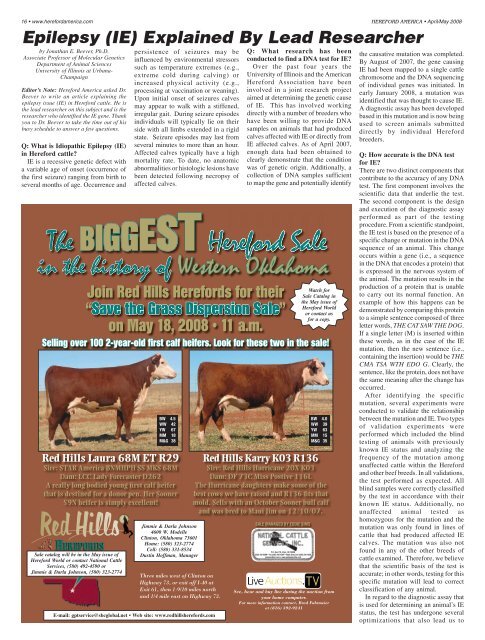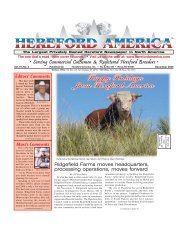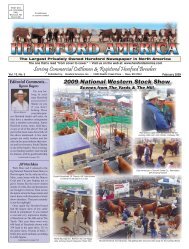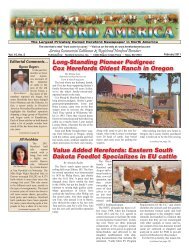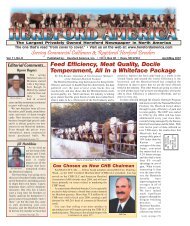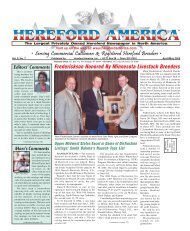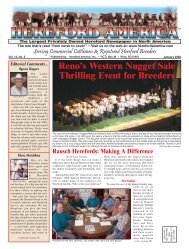April/May 2008 Issue (pdf - 7794 kb)... - Hereford America
April/May 2008 Issue (pdf - 7794 kb)... - Hereford America
April/May 2008 Issue (pdf - 7794 kb)... - Hereford America
Create successful ePaper yourself
Turn your PDF publications into a flip-book with our unique Google optimized e-Paper software.
16 • www.herefordamerica.com HEREFORD AMERICA • <strong>April</strong>/<strong>May</strong> <strong>2008</strong><br />
Epilepsy (IE) Explained By Lead Researcher<br />
by Jonathan E. Beever, Ph.D.<br />
Associate Professor of Molecular Genetics<br />
Department of Animal Sciences<br />
University of Illinois at Urbana-<br />
Champaign<br />
Editor’s Note: <strong>Hereford</strong> <strong>America</strong> asked Dr.<br />
Beever to write an article explaining the<br />
epilepsy issue (IE) in <strong>Hereford</strong> cattle. He is<br />
the lead researcher on this subject and is the<br />
researcher who identified the IE gene. Thank<br />
you to Dr. Beever to take the time out of his<br />
busy schedule to answer a few questions.<br />
Q: What is Idiopathic Epilepsy (IE)<br />
in <strong>Hereford</strong> cattle?<br />
IE is a recessive genetic defect with<br />
a variable age of onset (occurrence of<br />
the first seizure) ranging from birth to<br />
several months of age. Occurrence and<br />
<br />
<br />
<br />
<br />
<br />
<br />
<br />
<br />
<br />
<br />
<br />
<br />
<br />
<br />
<br />
<br />
<br />
Sale catalog will be in the <strong>May</strong> issue of<br />
<strong>Hereford</strong> World or contact National Cattle<br />
Services, (580) 492-4590 or<br />
Jimmie & Darla Johnson, (580) 323-2774<br />
persistence of seizures may be<br />
influenced by environmental stressors<br />
such as temperature extremes (e.g.,<br />
extreme cold during calving) or<br />
increased physical activity (e.g.,<br />
processing at vaccination or weaning).<br />
Upon initial onset of seizures calves<br />
may appear to walk with a stiffened,<br />
irregular gait. During seizure episodes<br />
individuals will typically lie on their<br />
side with all limbs extended in a rigid<br />
state. Seizure episodes may last from<br />
several minutes to more than an hour.<br />
Affected calves typically have a high<br />
mortality rate. To date, no anatomic<br />
abnormalities or histologic lesions have<br />
been detected following necropsy of<br />
affected calves.<br />
<br />
Jimmie & Darla Johnson<br />
<br />
4600 W. Modelle<br />
<br />
Clinton, Oklahoma 73601<br />
<br />
Home: (580) 323-2774<br />
<br />
Cell: (580) 331-8534<br />
Dustin Hoffman, Manager<br />
<br />
<br />
<br />
<br />
<br />
E-mail: <br />
gptservice@sbcglobal.net • Web site: www.redhillsherefords.com<br />
Q: What research has been<br />
conducted to find a DNA test for IE?<br />
Over the past four years the<br />
University of Illinois and the <strong>America</strong>n<br />
<strong>Hereford</strong> Association have been<br />
involved in a joint research project<br />
aimed at determining the genetic cause<br />
of IE. This has involved working<br />
directly with a number of breeders who<br />
have been willing to provide DNA<br />
samples on animals that had produced<br />
calves affected with IE or directly from<br />
IE affected calves. As of <strong>April</strong> 2007,<br />
enough data had been obtained to<br />
clearly demonstrate that the condition<br />
was of genetic origin. Additionally, a<br />
collection of DNA samples sufficient<br />
to map the gene and potentially identify<br />
<br />
<br />
<br />
<br />
<br />
<br />
<br />
<br />
<br />
<br />
<br />
Watch for<br />
Sale Catalog in<br />
the <strong>May</strong> issue of<br />
<strong>Hereford</strong> World<br />
or contact us<br />
for a copy.<br />
<br />
<br />
<br />
<br />
<br />
<br />
<br />
<br />
<br />
the causative mutation was completed.<br />
By August of 2007, the gene causing<br />
IE had been mapped to a single cattle<br />
chromosome and the DNA sequencing<br />
of individual genes was initiated. In<br />
early January <strong>2008</strong>, a mutation was<br />
identified that was thought to cause IE.<br />
A diagnostic assay has been developed<br />
based in this mutation and is now being<br />
used to screen animals submitted<br />
directly by individual <strong>Hereford</strong><br />
breeders.<br />
Q: How accurate is the DNA test<br />
for IE?<br />
There are two distinct components that<br />
contribute to the accuracy of any DNA<br />
test. The first component involves the<br />
scientific data that underlie the test.<br />
The second component is the design<br />
and execution of the diagnostic assay<br />
performed as part of the testing<br />
procedure. From a scientific standpoint,<br />
the IE test is based on the presence of a<br />
specific change or mutation in the DNA<br />
sequence of an animal. This change<br />
occurs within a gene (i.e., a sequence<br />
in the DNA that encodes a protein) that<br />
is expressed in the nervous system of<br />
the animal. The mutation results in the<br />
production of a protein that is unable<br />
to carry out its normal function. An<br />
example of how this happens can be<br />
demonstrated by comparing this protein<br />
to a simple sentence composed of three<br />
letter words, THE CAT SAW THE DOG.<br />
If a single letter (M) is inserted within<br />
these words, as in the case of the IE<br />
mutation, then the new sentence (i.e.,<br />
containing the insertion) would be THE<br />
CMA TSA WTH EDO G. Clearly, the<br />
sentence, like the protein, does not have<br />
the same meaning after the change has<br />
occurred.<br />
After identifying the specific<br />
mutation, several experiments were<br />
conducted to validate the relationship<br />
between the mutation and IE. Two types<br />
of validation experiments were<br />
performed which included the blind<br />
testing of animals with previously<br />
known IE status and analyzing the<br />
frequency of the mutation among<br />
unaffected cattle within the <strong>Hereford</strong><br />
and other beef breeds. In all validations,<br />
the test performed as expected. All<br />
blind samples were correctly classified<br />
by the test in accordance with their<br />
known IE status. Additionally, no<br />
unaffected animal tested as<br />
homozygous for the mutation and the<br />
mutation was only found in lines of<br />
cattle that had produced affected IE<br />
calves. The mutation was also not<br />
found in any of the other breeds of<br />
cattle examined. Therefore, we believe<br />
that the scientific basis of the test is<br />
accurate; in other words, testing for this<br />
specific mutation will lead to correct<br />
classification of any animal.<br />
In regard to the diagnostic assay that<br />
is used for determining an animal’s IE<br />
status, the test has undergone several<br />
optimizations that also lead us to


